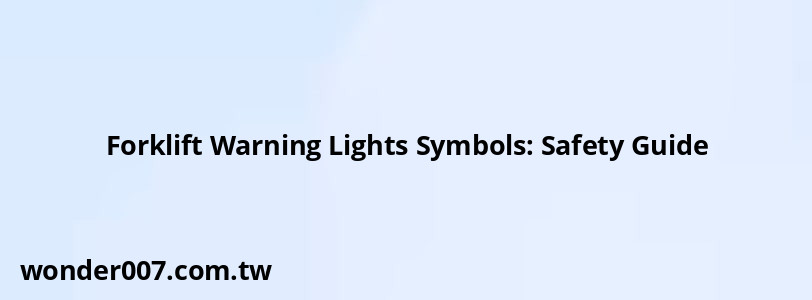Forklift Warning Lights Symbols: Safety Guide

Forklift Warning Lights
Forklift warning lights are crucial safety features that alert operators and nearby workers to potential hazards or issues with the equipment. Understanding these symbols is essential for maintaining a safe work environment and preventing accidents.
Forklift warning lights typically use a combination of colors and symbols to convey specific messages. The most common colors are red, yellow, and blue, each indicating different levels of urgency or types of warnings.
Common Forklift Warning Light Symbols
Battery Warning Light
This symbol usually appears as a battery icon and indicates low battery charge or issues with the charging system. When illuminated, operators should check battery connections and charge or replace the battery if necessary.
Engine Oil Pressure Light
Represented by an oil can symbol, this light warns of low oil pressure. If it remains on after starting the engine, operators should immediately stop the forklift and check the oil level to prevent engine damage.
Temperature Warning Light
A thermometer symbol indicates that the engine is overheating. Operators should shut off the engine, allow it to cool, and check coolant levels before resuming operation.
Hydraulic Oil Warning Light
This symbol often appears as an oil can with wavy lines beneath it. It signals low hydraulic fluid levels or issues with the hydraulic system, which can affect the forklift's lifting capabilities.
Brake Warning Light
Usually depicted as an exclamation mark inside a circle, this light indicates problems with the braking system. Operators should check brake fluid levels and brake pad condition before continuing use.
Blue Safety Lights
Many modern forklifts are equipped with blue safety lights that project onto the floor. These lights serve as a visual warning to pedestrians, alerting them to an approaching forklift, especially in blind spots or intersections.
Importance of Regular Maintenance
Regular maintenance is crucial for preventing warning lights from activating and ensuring safe forklift operation. Operators should:
- Perform daily pre-shift inspections
- Check fluid levels regularly
- Keep the forklift clean and free of debris
- Report any unusual sounds or performance issues immediately
Operator Training
Proper training is essential for forklift operators to understand and respond appropriately to warning lights. Training should cover:
- Recognition of all warning light symbols
- Proper procedures for addressing each warning
- The importance of not ignoring or overriding warning lights
Conclusion
Understanding forklift warning light symbols is crucial for maintaining a safe work environment. Operators and managers should prioritize regular training, maintenance, and prompt response to warning lights to prevent accidents and ensure efficient operations.
FAQs About Forklift Warning Lights Symbols
- What should I do if multiple warning lights come on at once?
Immediately stop the forklift in a safe location, turn off the engine, and report the issue to your supervisor. Do not attempt to operate the forklift until it has been inspected by a qualified technician. - Are forklift warning light symbols universal across all brands?
While many symbols are similar across brands, there can be variations. Always refer to the specific forklift's operator manual for accurate information on warning light symbols and their meanings. - How often should forklift warning lights be tested?
Warning lights should be checked as part of the daily pre-shift inspection. If any lights fail to illuminate during the check, report it immediately for maintenance.
Related Posts
-
2001 Dodge Ram 1500 Heater Core Replacement Guide
26-01-2025 • 138 views -
John Deere 5075E: Understanding Warning Lights and Their Meanings
26-01-2025 • 186 views -
Freightliner Dash Warning Lights: A Comprehensive Guide
26-01-2025 • 209 views -
Toyota Yaris Key Fob Battery Replacement Guide
26-01-2025 • 156 views -
Power Steering Fluid for 2006 Nissan Altima: Essential Guide
29-01-2025 • 172 views
Latest Posts
-
2015 Chevy Traverse AC Recharge Port Location
01-02-2025 • 339 views -
Power Steering Fluid Leak On Passenger Side
01-02-2025 • 392 views -
How To Turn Off Paddle Shifters Mercedes
01-02-2025 • 306 views -
Are O2 Sensors Covered Under Warranty
01-02-2025 • 313 views -
Rear Brake Caliper Piston Won't Compress
01-02-2025 • 287 views
Popular Posts
-
EPC Light: Understanding Causes and Solutions
26-01-2025 • 990 views -
Power Steering and ABS Light On: Causes and Solutions
27-01-2025 • 582 views -
V12 Engine Costs: What You Need to Know
26-01-2025 • 584 views -
2015 VW Passat Oil Consumption Issues Explained
26-01-2025 • 544 views -
EPC Warning Light: What It Means for Your Vehicle
27-01-2025 • 559 views
